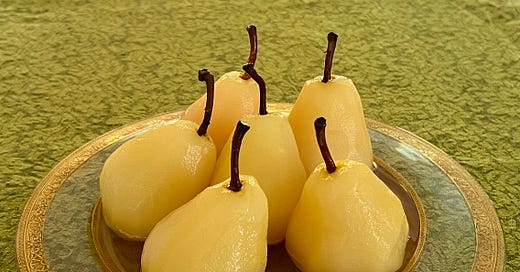Pears of nearly all varieties ripen off the tree, although they have to reach a certain maturity first. Once they’re picked, they benefit from some chilling, the length of time depending on the variety. Then they ripen at cool room temperature, becoming softer, juicier, less acidic, and more aromatic. They’re ready when their shoulders yield to moderate pressure (experience helps); a day later they may be overripe. For poaching, use them at least a day early. Among the more common varieties, I like Comice (though more than other varieties, a really ripe Comice becomes too soft when cooked). Depending on where you are, you may have to settle for the more easily found Bartlett (outside North America known as Williams or Bon Chrétien) or D’Anjou. I buy extra pears, let them ripen for a day or more as needed and choose the best for poaching. Red-wine poached pears are bolder; the white-wine version shows more pear flavor. Serve the poached pears by themselves or with a cookie, a slice of cake (such as this torta di nocciole), or whipped cream.
500 ml white wine
500 ml water
200 gr (1 cup) sugar
1 vanilla bean
a dozen black peppercorns, 1 whole clove, and 1 allspice berry, preferably tied in cheesecloth so they don’t become embedded in the pears
a piece of lemon zest about 5 cm (2 inches) square
6 not-quite-ripe pears, peeled leaving the stems and cored from the bottom using a melon baller or a small sharp spoon
In a nonreactive pot that’s tall rather than wide, combine all the ingredients except the pears, and bring the liquid briefly to a boil, stirring to dissolve the sugar. Simmer the pears slowly in the liquid, adding water if needed to cover, rotating them once or twice with a wooden spoon (so as not to cut into them with a metal one), until they are cooked through (scarcely resisting a narrow blade) — 30 minutes to 1 hour, depending on the pears’ variety and ripeness. Cool the pears, covered, in the syrup.
Remove the pears by the stem or with a wooden spoon, and place them on a serving dish. Set each pear upright, taking a thin slice off the bottom if necessary to stabilize it. Discard the spices, and boil the liquid until it’s reduced by about two-thirds to a slightly thick syrup — at that point it will boil over if not stirred down. Cool the syrup to room temperature, and just before serving spoon it over the pears to give them a light, ephemeral glaze. Serves 6.







After a thorough scolding at the fruit market when I pressed my finger in the flesh of the pear to test ripeness I still see the sign written in pencil on a piece of cardboard, “don’t touch the pears”
What white wine would you use for this, Ed? Something on the fruity side? A riesling? I'm reminded of the pears poached in red wine we used to enjoy in Roman restaurants. I think they've disappeared, along with so many other delicious things of yore.